What’s active when it’s hot? — and what’s not? !!!
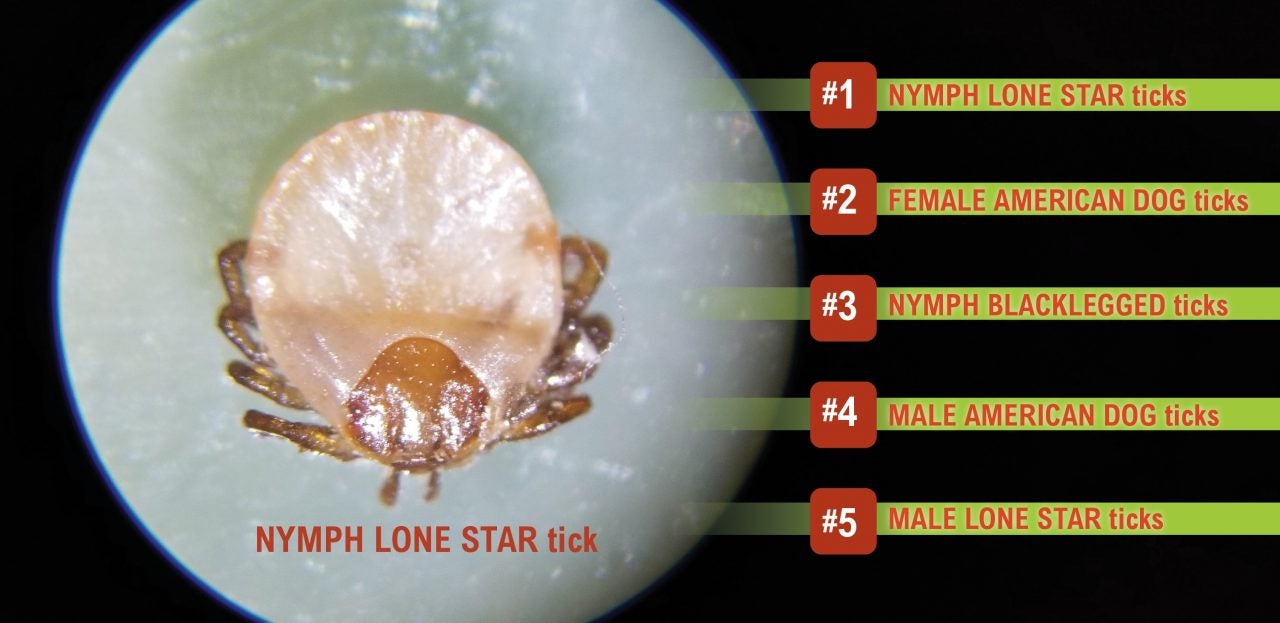
When it’s springtime, the question I’m asked most often is some version of “how are the ticks going to be this summer?” Since you’re reading this, maybe that’s something you want to know, too? The question often comes along with a lot of speculation being offered related to the past winter’s weather – it was cold; there was no snow cover; it was warm; there was a ton of snow — as if any of that is the leading determinant of summertime tick activity. It turns out that most types of ticks have locked down the part about successfully getting through winter in their normal region of activity. Abundance of summertime ticks, and by extension, summertime tick encounters then, is more about tick reproduction in the preceding year along with survival based on environmental conditions once they become active.
While May is technically not summer, it is consistently the tickiest month of the year in North America. But June is usually a close second, and when you add in July and early August, and the fact that summer usually is when people are outsiders and more tick exposed, the summer months are when people and pets encounter the most ticks. And most tickborne diseases are contracted during summer, too.
Something I’ve come to appreciate when asked about “how the ticks are going to be this summer?”, is that there’s no easy answer. I’ve started telling reporters, especially for national media, “that depends!” It usually startles them because it’s not the answer they were expecting. But it really depends on which type of tick you’re talking about, and the region, too. While I suppose there could be years when the confluence of conditions driving tick populations results in similar impacts across the whole of North America, that would be a coincidence or happenstance rather than something predictable. It actually makes sense though, that only when you “unpack” the word “ticks” is when you can begin to realize that different types of ticks have different factors driving their population levels. It’s more likely the case that certain regions will have up years for certain types of ticks while other regions where those same ticks can occur, end up experiencing lower or the same amount of tick encounters. So, when I get asked, my next comment is usually that we would need to unpack which type of tick, and where. Or if the questioner doesn’t seem to have the time for much unpacking, there’s always the easy answer, which is, there’s going to be more ticks than most people can tolerate, since, with the fear of Lyme disease, that number is usually one tick is one too many.
But it’s super important to correctly identify every tick encounter because different types of ticks carry and transmit different germs. Let’s get even more specific, good science has well documented that not every type of tick gives people Lyme disease!! But blacklegged ticks, and their cousins around the globe, do carry and efficiently transmit the Lyme disease germ, so being able to recognize the nymph and adult stages of these ticks even (and especially) when their appearance changes as they engorge is important. But perhaps just, or even more important, is to recognize what is not carrying the Lyme disease germ so as not to fret needlessly or take unnecessary antibiotics as a precaution to prevent an infection you weren’t exposed to anyway.
Our TickSpotters Index, based on national tick encounter submissions, is able to suggest trends and help document tick encounter levels in near real-time. Here is our list of the 5 most active SummerTime ticks, at least, so far this summer. Do any (or maybe all) of these ticks live where you do?
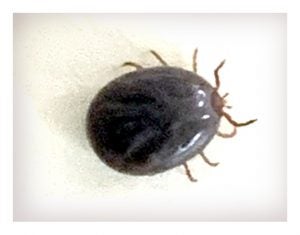
#1 – NYMPH LONE STAR ticks are leading the pack when it comes to number of reported encounters. This tick starts as small, round, amber-colored specks sometimes even seeming to come in swarms. They are aggressively speedy; the time from when they latch on until they are up your legs, crawling under your shorts or shirt, and digging in for blood is frequently just a couple of minutes. Hot spots for encountering these ticks include Maryland, New Jersey, Virginia, Missouri, Kentucky, and the eastern end of Long Island. They’re also on the increase in Indiana. We’ve collected helpful information about Lone Star ticks at this link. [does NOT transmit Lyme disease].
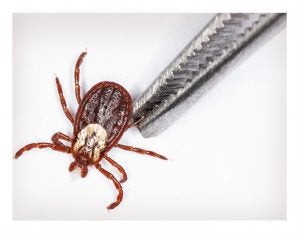
#2 – FEMALE AMERICAN DOG ticks are the most widely dispersed summertime active tick. Found in most states, these are the ticks that most people over 50 grew up with. They’re the ones that crawl up your clothes and often end up biting on top of your head. No, they don’t fall out of trees! But pets and people can carry them loose and wandering inside where they are able to withstand lower humidities and remain a threat for latching on for a few days. [does NOT transmit Lyme disease].
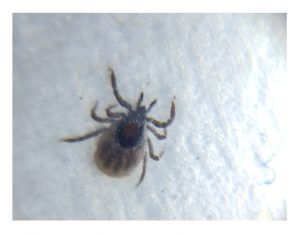
#3 – NYMPH BLACKLEGGED ticks start out looking like a poppy seed attached to your skin. They are commonly found attaching to places where skin folds or clothing restricts their movement – backs of knees, waistbands, bra straps, watch bands are all first-line places to check. And check daily because in the northern portion of this tick’s range 20-30% could be carrying some germ that can make you or your pet sick. Besides Lyme disease, there are the germs causing babesiosis, anaplasmosis, hard tick relapsing fever, and more rare, Powassan virus. [does transmit Lyme disease].
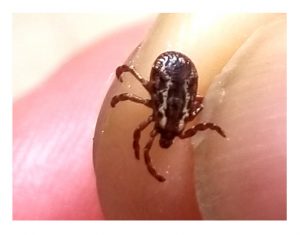
#4 MALE AMERICAN DOG ticks were the most active type of tick during May, but as summer gets started it seems that people encounter the females more frequently than the males, and that’s what we’ve been seeing this year, too. Male American dog ticks do attach and feed for 12 hrs-2 days to stimulate their sperm but then detach and wander in search of a mate. Like the female American dog tick, the males will start to fade away by early August. [does NOT transmit Lyme disease].
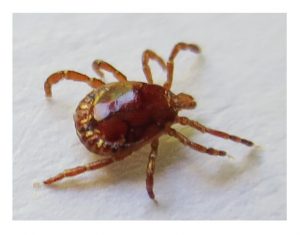
#5 MALE LONE STAR ticks are the least well recognized of the commonly encountered ticks in America. While the female Lone Star tick sports a bright white pigment spot in the middle of its back, that white pigment gets spread out on the male, usually along the back margin; sometimes it’s more obvious, and sometimes less so. These ticks are aggressive and super-fast but are intermittent feeders, like male American dog ticks, and even if you see it wandering, it still may have bitten…someone. [does NOT transmit Lyme disease].
And in summer, do you know which ticks you can pretty much take off of your radar? Most notably, adult stage blacklegged ticks. While there may still be a few out there, especially in the more northern parts of this tick’s range, it’s good to remember that their season of activity starts in October and runs through the winter an into spring and then they “go away” during summer.
Do you have a tick picture you’d like to submit? Be sure your picture shows the top side where the type distinctive markings usually are found. Find the submission form at TickSpotters.
